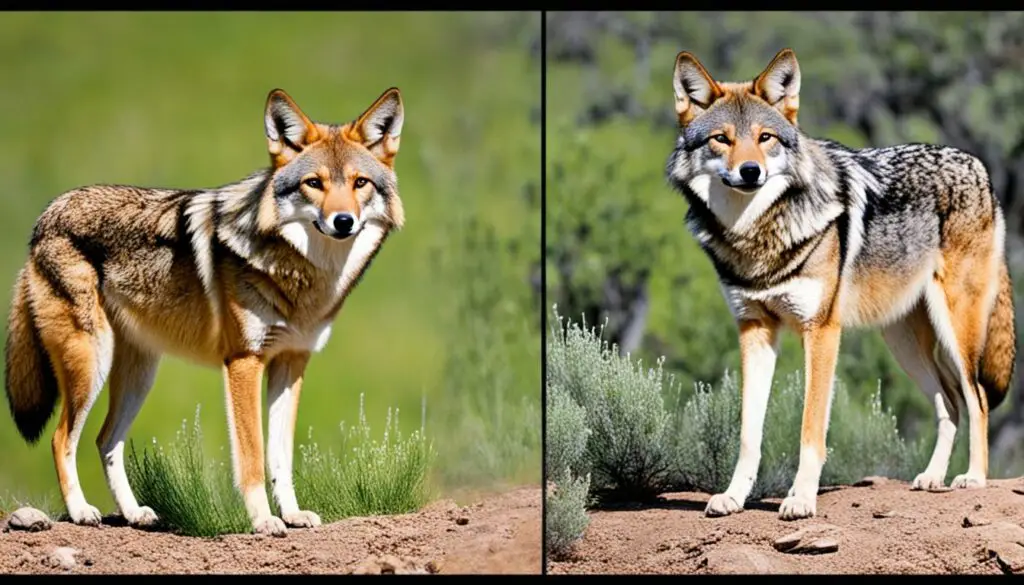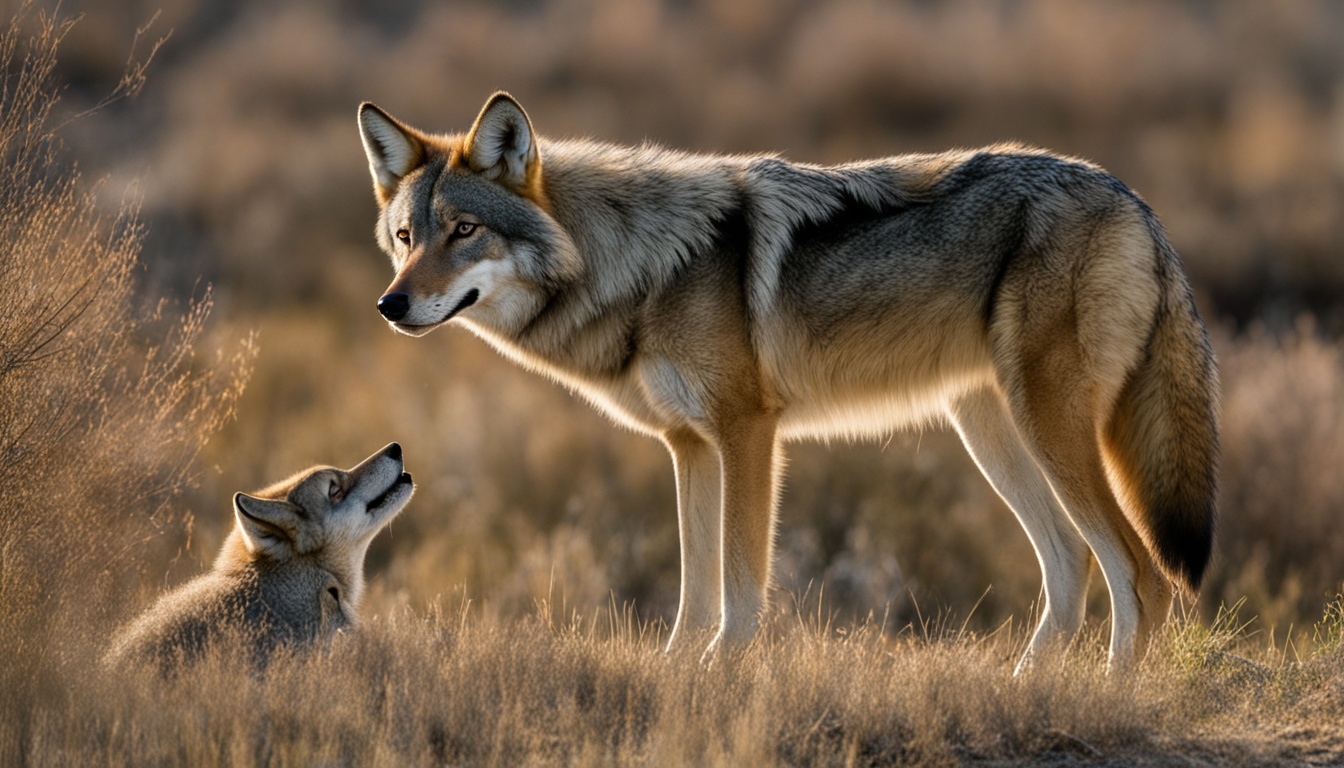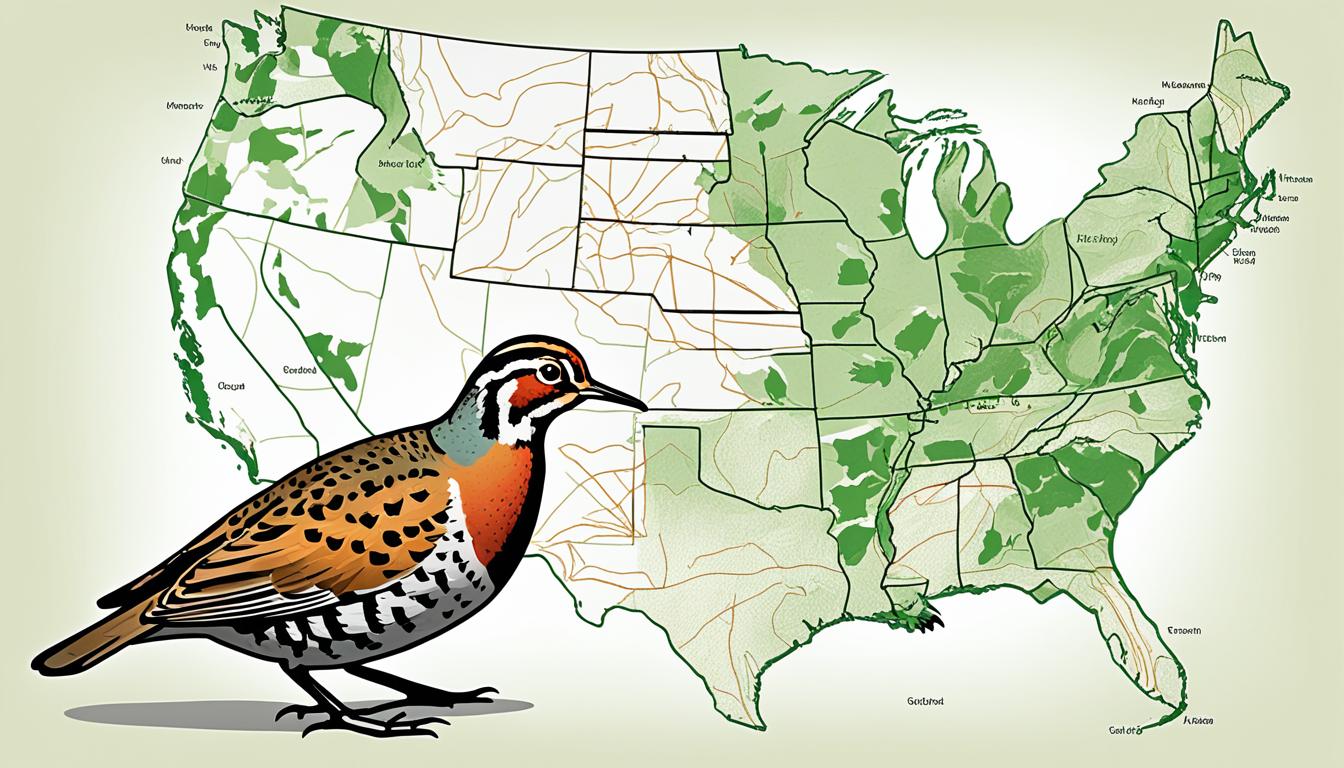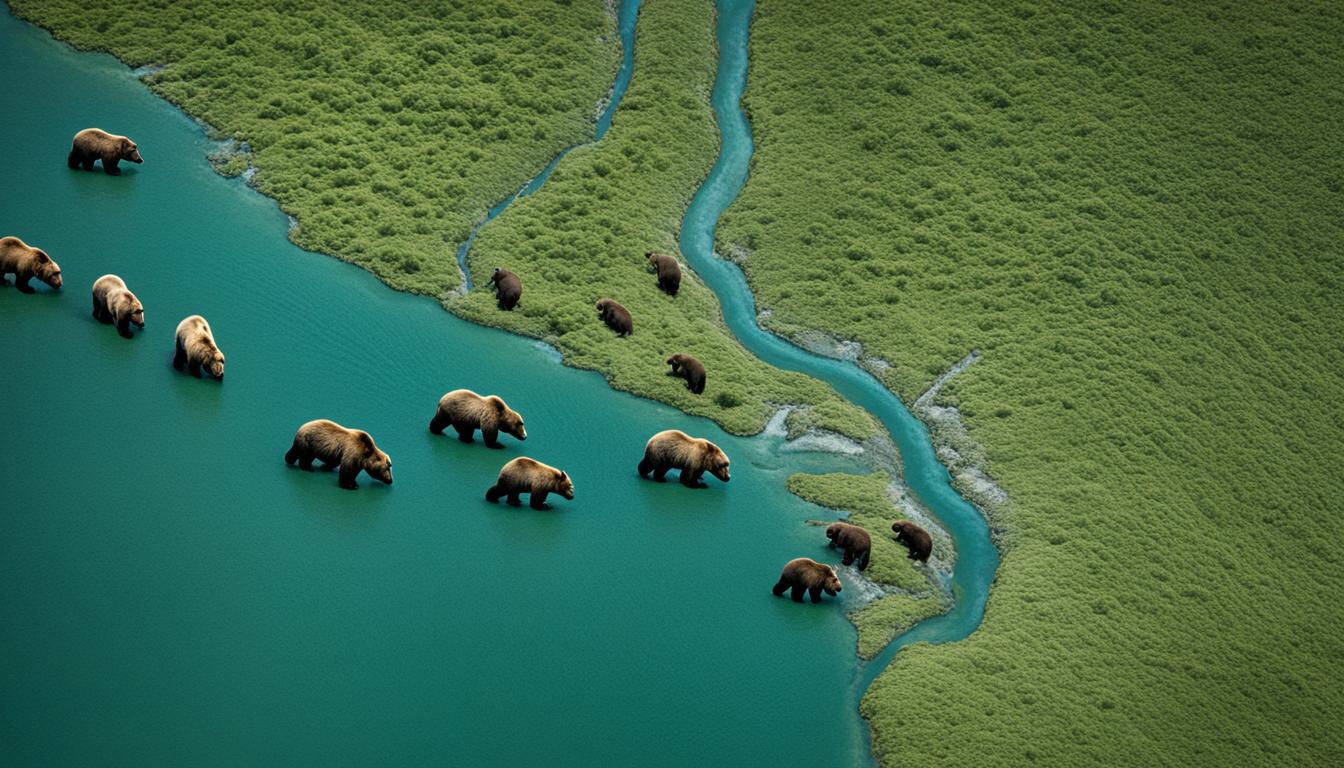Have you ever seen a wild dog and thought, “Is that a coyote or a wolf?” Both look pretty similar but knowing a few key differences can help. Things like their size, face, tracks, and sounds are important. By learning these details, you can be better at telling coyotes and wolves apart. This also helps with protecting our wildlife better.
Now, we’ll look deeper to learn how to spot the differences between coyotes and wolves.
Physical Size Differences Between Coyotes and Wolves
Knowing how coyotes and wolves differ in size is key to telling them apart. They vary in terms of height, length, weight, and their overall look. This gives us a clear way to compare them.
Height and Length
Wolves are much bigger than coyotes when it comes to height and length. They stand around 30 inches tall and can stretch up to 6 feet in length, tail included. Coyotes, on the other hand, are about 18 inches tall and reach up to 4 feet long.
Weight Comparison
In the weight department, wolves are a lot heavier than coyotes. Males tip the scales at 95-100 pounds, with females a bit lighter. Coyotes are much lighter, weighing between 15 to 45 pounds.
Build and Posture
How they’re built is a big clue to telling coyotes and wolves apart, too. Wolves have a sturdy head, a back that slopes, and strong, long legs. This makes them look more powerful and scary. Coyotes, however, are slender and quick, resembling a fox more with their looks and the way they carry themselves.
Facial Structure and Features
Coyotes and wolves have unique facial structures. These features are important when telling them apart. By looking at their faces, you can see clear differences.
Snout and Muzzle Size
The snout and muzzle size differences between these animals are obvious. Wolves have broader snouts, adding to their sturdy look. On the other hand, coyotes have slimmer, longer noses. This makes their faces seem more stretched out.
Ear Shape and Size
When looking at coyote vs wolf differences, ear shape and size play a big part. Wolves have compact, round ears that fit their larger bodies. They look like some domestic dog breeds for this reason. In contrast, coyotes have big, sharp ears. Their ear shape helps give them a fox-like appearance. These ear details are key in telling them apart.
Understanding these facial features helps you know if you’re seeing a coyote or a wolf. It lets you make smart and accurate observations.
Coat Coloration and Texture
Wolves and coyotes have very different looks when it comes to their coats. These differences help each animal blend in and survive in their surroundings.
Variations in Coat Color
Wolves come in many shades from white to black and including reddish tones. This variety helps them hide well in different landscapes. On the other hand, coyotes are often a tan or buff color. They’re quite rare, but sometimes you can find a black coyote, making them stand out.
Coat Texture and Density
The feel of the fur also sets wolves and coyotes apart. Wolves have thick fur perfect for keeping warm in cold places. This thick fur makes them look big and strong. Coyotes, on the other hand, have softer, lighter fur. It helps them survive in both hot and cold areas. They’re known for being able to live in many places.
| Aspect | Wolves | Coyotes |
|---|---|---|
| Color Range | White to Black, Buff, Reddish Hues | Buff-Tan, Occasional Black |
| Coat Texture | Dense, Thick | Fine, Thin |
| Adaptation to Climate | Cold, Harsh Environments | Various, Including Arid Regions |
Identifying Tracks: Coyote vs Wolf
First, look at the track size and shape to tell if it’s a coyote or wolf. Wolves have bigger tracks than coyotes. Wolf tracks are about 5 inches long and 4 inches wide. Coyote tracks are smaller, at about 3 inches long and 2.5 inches wide.
Pay attention to the track’s shape. Wolf tracks are symmetrical and show four toes and claws clearly. Coyote tracks also show claw marks but they appear smaller and closer together.
Behavioral Patterns in Tracks
The way tracks are laid out can also point you in the right direction. Wolf tracks are usually in a straight line, showing their focused movement. In comparison, coyote tracks wander more. This suggests they’re either hunting or looking for food.
By noticing these patterns, you can guess which animal made the tracks.
How to Interpret Vocalizations
Understanding the sounds made by coyotes and wolves shows us how they talk to each other. It helps us tell these two animals apart in the wild.
Types of Sounds
Wolves howl in a deep voice, which can be heard from miles away. This type of call helps them stay close and alert others about their group’s location. Coyotes, however, make high-pitched sounds like yips and barks. They do this to warn about danger and to plan hunts with their clan.
Purpose of Vocalizations
Figuring out what these animals are saying means knowing why they make each sound. For wolves, howling is about keeping in touch and protecting their area. They might howl to celebrate a kill or to grieve a lost pack mate.
Coyotes, on the other hand, make quick sounds to handle daily challenges. They might yip to warn their family of danger. Or they might bark to scare off rivals. Their different sounds help them deal with a range of situations.
Habitat Preferences and Ranges
Knowing where wolves and coyotes like to live is key for looking after wildlife. They each choose different homes. This affects where we find them and how they act.
Preferred Environments
Wolves love big, wild areas the most. These are usually forests full of big prey. They need a lot of space for their groups, around 40 to 50 square miles. This also depends on how much food is around.
But coyotes can live in lots of places. They do well in the country, suburbs, and even cities. Unlike wolves, they’re fine with a smaller area, sometimes just a few miles across.
Geographical Distribution
Wolves mostly live in the north of the US. They like places with fewer people. So, there aren’t as many of them around.
On the other hand, coyotes are spread out all over the US. They can live in many different kinds of places. This shows how they can adapt and survive in lots of environments.

| Characteristic | Wolves | Coyotes |
|---|---|---|
| Preferred Environments | Wild, forested regions with large prey | Diverse environments including urban areas |
| Geographic Range | Northern states | Nearly every state |
| Territory Size | 40-50 square miles | A few square miles |
Diet and Hunting Behavior
Learning about what wolves and coyotes eat and how they hunt tells us a lot. It helps us see their place in nature and what they do to survive. Plus, it shows the effect they have on their homes.
Types of Prey
Wolves eat mainly big animals like deer, moose, and elk. They do this as a team, allowing them to go after larger prey. This hunting style helps them chase bigger game. On the other hand, coyotes are more flexible in what they eat. They mix in plants, small animals, and sometimes big animals, like deer. They switch their diet based on what’s available each season. This comparison of diet and hunting shows how coyotes make the best of what’s around.
Hunting Tactics
Wolves use teamwork to hunt. By working together, they increase
their chances of catching their meal while using less energy. Their social skills and planning shine during the hunt. In comparison, coyotes are known for their versatility. They can hunt alone or with a partner, using their sharp noses and quick bodies to their advantage. They use a mix of strategies like stalking, waiting in ambush, and even scavenging. This adaptability shows us coyotes are ready for different hunting situations.
Let’s look closely at how wolves and coyotes hunt and what they eat:
| Aspect | Wolves | Coyotes |
|---|---|---|
| Primary Prey | Large ungulates (deer, moose, elk) | Mixed (vegetation, small mammals, occasionally deer) |
| Hunting Strategy | Pack-based coordination | Solo or pairs; versatile tactics |
| Behavior | Highly organized, strategic | Opportunistic, flexible |
Behavioral Traits and Social Structure
It’s key to know about the behaviors and how wolves and coyotes live in groups. They act differently but show interesting social ways. This relates to how they live in areas and with each other.
Pack and Family Dynamics
Wolves have complex groups called packs, with many family units living together. These groups are big and have a lot of different roles. The main goal is to hunt together and look after the young ones. On the other hand, coyotes live in smaller family units. They usually include a mom, dad, and their kids. This simple structure helps them survive in their environments but isn’t as big as the wolf packs.
Territorial Behavior
Wolves need a lot of space because they have big hunting grounds. Their territories can be up to 1,000 square miles. This space is for food and shelter for their pack. In sharp contrast, coyotes can live in more places. They are good at making do with smaller areas, like just a few square miles. This skill lets them live near people and in many different habitats.
Knowing about the social and living habits of wolves and coyotes shows how they fit into their worlds. This knowledge helps us protect them and avoid problems with people.










